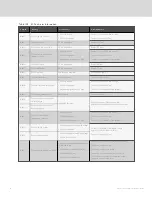
1.
Turn Off the disconnect switch on the condenser enclosure cover.
2.
Open the control enclosure cover.
3.
Manually turn On the disconnect switch.
NOTE: Power is On and a shock hazard exists with exposure to hazardous voltage components.
4. If the board can still be powered up and has a display, record the parameter settings.
To obtain parameters go to the
C--
menu and press the UP or DOWN arrow button to read and record the
values for C03-09 and C27.
5.
Record all of the DIP switch positions for the CANbus DIP switch package. Retain these for setting up the new
board.
6. Record the positions of the jumpers for J2, J4, J5 and J6 on control board in the unit. Retain these for setting up
the new board.
7.
Disconnect power from the condenser by turning Off the main disconnect switch.
8.
Use a voltmeter to verify that voltage is no longer present in the unit.
9. Remove the plugs and field installed wires from the old board. Note the polarity for the CANbus wiring going to
P49 and P50, if present.
10. Mark wires P49-1, P49-3, etc, if they are not already marked.
11. Remove the mechanical fasteners holding the control board in place and remove the old control board.
12. Install the new control board using the fasteners removed in step 11.
13. Reattach the plugs. Refer to the hot stamps on the wire harnesses that correspond to the correct plug on the
board. Verify that the plugs are installed properly.
14. Change the CANbus DIP switch positions so they match the control board that was removed. If the condenser is
the second condenser on the CANbus communication line, set Position 1 of the CANbus DIP switch from On to
Off.
15. Change the jumper positions for J2, J4, J5 and J6 to match the control board that was removed. If the
condenser is the last device on the CANbus communication line, move the jumper at J6 from Pins 2 and 3 to
Pins 1 and 2 (see Figure 11.4 on the previous page).
16. Power up the unit.
17. Change the parameters to match the parameters from the control board that was removed if they were
obtained from the old board in step 4. See step 18 if the parameters were unavailable.
18. If the old board parameters were unavailable, use the new HMI label included in kit to obtain the proper
settings. Parameters C03, C04, C05 and C06 must be programmed with the proper EC fan supplier used on
the unit.
19. Address the fans (refer to
20. Compare the HMI label on the unit with the latest revision.
If there are differences, clean and dry the surface of the old HMI label; attach the new label on top of the old
label, covering the old label with the new one.
21. Verify that the control board is reading pressure and temperature.
22. Verify that there are no communication alarms with the fans or with the cooling unit the condenser is serving.
23. Verify proper fan operation by adjusting the cooling unit that this condenser serves so that it calls for cooling.
Vertiv | Liebert® MC Installer/User Guide
68
Summary of Contents for Liebert MC series
Page 1: ...Liebert MC Installer User Guide 60 Hz Air Cooled Microchannel Condenser Premium EC Fan ...
Page 8: ...Vertiv Liebert MC Installer User Guide 4 This page intentionally left blank ...
Page 14: ...Vertiv Liebert MC Installer User Guide 10 This page intentionally left blank ...
Page 28: ...Vertiv Liebert MC Installer User Guide 24 This page intentionally left blank ...
Page 44: ...Vertiv Liebert MC Installer User Guide 40 This page intentionally left blank ...
Page 46: ...Vertiv Liebert MC Installer User Guide 42 This page intentionally left blank ...
Page 48: ...Vertiv Liebert MC Installer User Guide 44 This page intentionally left blank ...
Page 76: ...Vertiv Liebert MC Installer User Guide 72 This page intentionally left blank ...
Page 88: ...Vertiv Liebert MC Installer User Guide 84 This page intentionally left blank ...
Page 90: ...Vertiv Liebert MC Installer User Guide 86 This page intentionally left blank ...
















































